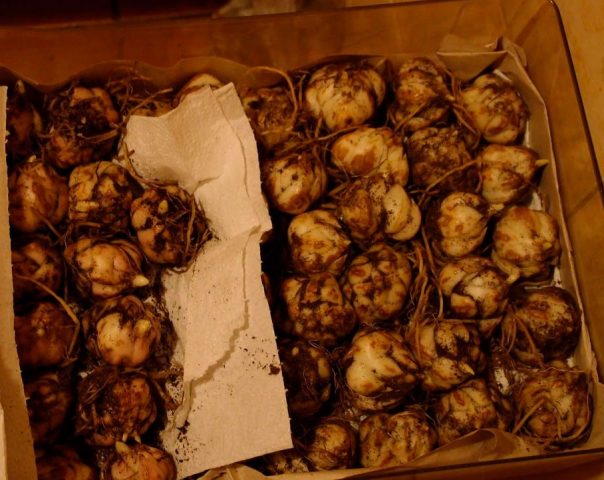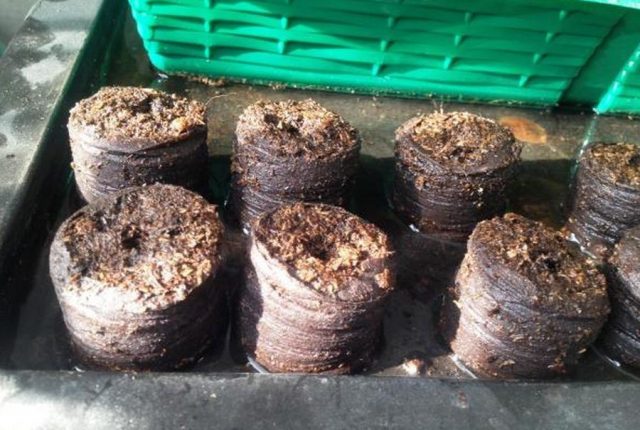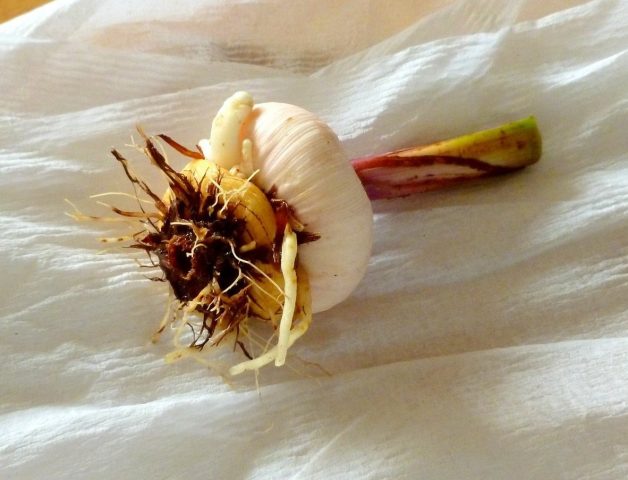Content
Lily bulbs can be stored both indoors and outdoors before planting. In order for the material to survive safely until spring, you need to provide it with comfortable conditions.
How to properly store lily bulbs
Lily bulbs are dug up from mid-August to mid-September, depending on the variety. After this, they need to be stored until planting in the spring.
You can keep the material in a sheltered area, on a balcony or in a basement, in a refrigerator. Each method has its own advantages. To ensure that the material does not die before planting and survives the winter safely, you need to worry about some nuances.
Storage conditions
Before planting in the ground, lilies should be stored in comfortable conditions. In particular, tubers need to be provided with:
- moderate humidity - in a damp room, lilies will rot or germinate prematurely;
- good ventilation - musty air promotes the development of fungal diseases;
- low temperature - it is best to store the bulbs at 0-4 ° C, in which case they will not freeze, but will not begin to germinate.
Although lilies are harmed by excess humidity in winter, keeping them in too dry a room is also not recommended. In this case, the tubers will begin to shrink and die before spring planting.
Preparing bulbs for storage
In order to store lily tubers in winter without problems, it is necessary to carry out special preparation for them. The diagram looks like this:
- The collected tubers are washed in running water to remove soil residues.
- Carry out a thorough inspection of the material.
- Throw away all damaged tubers with traces of fungal diseases.
- Lay the material out to dry in a ventilated area at a temperature of about 16 °C.
After the tubers are completely dry, they can be sprinkled with wood ash to protect them from fungi.

It is recommended to store lily bulbs of approximately the same size until spring
Where to store lily bulbs in the fall before planting
It is necessary to store dug up lilies in conditions of moderate temperature and humidity. Several options are especially popular.
In the ground
At your summer cottage, you can put lilies directly in the ground for the winter. The material is collected for storage as follows:
- In mid-autumn, dig a shallow trench in the ground - the bulbs should fit completely into it with a small margin.
- Strengthen the walls of the ditch with boards so that they do not collapse.
- Place a layer of sand or pebbles at the bottom of the trench to ensure drainage.
- Place boxes in the ditch and cover the top with sawdust or peat.
With the arrival of the first frost, it is necessary to organize insulation for the planting material.A plastic film is stretched over the trench, and cardboard is placed on top of it. The ditch is covered with earth, a layer of dry leaves and spruce branches. The colder the winter is expected, the better the bulbs need to be insulated before planting.
In a refrigerator
You can store lily bulbs in your apartment in the winter in the refrigerator. The method is convenient in that it allows you to provide a stable optimal temperature for the material intended for planting.
Before putting the bulbs in the refrigerator, you need to put them in a plastic bag and pour a damp mixture of sawdust and peat inside. It is recommended to make several small holes to improve ventilation. Once a week, check the bag and, if necessary, re-moisten the substrate.
Lilies should be stored in the refrigerator separately from vegetables and fruits. The latter emit gases containing ethylene and disrupt the respiration processes of the bulbs. This increases the likelihood of material rotting.
In the basement, cellar
You can store lily bulbs in the winter before planting in the basement or cellar. The method is used if there is quite a lot of plant material and it cannot be placed in the refrigerator. The tubers are placed in a wooden box and sprinkled with slightly moistened sawdust with the addition of peat. The container should be placed in the dryest possible place indoors.
The cellar can only be used if the temperature in it in winter does not fall below 0 °C. It is necessary to abandon the method if the basement is too cold, damp, or the conditions in it change sharply during thaws and cold snaps.
On the balcony
You can store lily bulbs purchased in February on the balcony or loggia. The method is considered not the most convenient, but in a city apartment it often becomes the only one available.
Before storage, lilies are placed in boxes filled with sawdust. Containers should be placed in a place where sunlight does not reach. When it gets very cold, the boxes are brought indoors and covered with burlap or agrofibre.

The main disadvantage of storing lilies on the balcony is that it is impossible to provide the tubers with a stable temperature
Other storage methods
To make it more convenient to store the bulbs before planting, they are placed in a variety of containers. Sometimes the material is left on the site, but more often it is removed underground or brought indoors.
In packages
The easiest way is to put the bulbs in a bag before planting. Plastic bags are found in every home; they are an affordable and cheap consumable material. However, when using bags, there is often a problem with excess moisture, which can cause the lilies to rot.
To prevent this from happening, it is necessary to make a sufficient number of holes in the polyethylene for ventilation. Before storing the bulbs before planting, you need to sprinkle them with moistened peat and sand.
In stockings
You can store lilies until spring planting not only in bags, but also in stockings. The material allows air to pass through perfectly, and tubers rarely begin to rot from dampness.
To easily store the bulbs before planting in the spring, you need to put them in a stocking, 2-3 pieces at a time.After this, the tubers are hung in a pantry or dry basement, where the temperature is kept at about 5 ° C throughout the winter.
In flowerpots
It is recommended to store lilies in flowerpots before planting if during the winter the material began to germinate prematurely. In this case, it is impossible to completely stop the unwanted process, but you can slow it down.
Loose nutrient substrate is poured into the flowerpots and slightly moistened, and then the germinating tubers are planted. The containers must be placed in a shaded place to store lily bulbs at a temperature of about 5 °C.
With the onset of spring, the flowerpots will need to be moved to a well-lit windowsill. When the plants get a little stronger, they can be transplanted into open ground.

The selected flowerpots should be spacious enough so that the root system of the bulbs develops freely
In boxes
Storage in boxes is a popular way to provide tubers with comfortable conditions without unnecessary difficulties. Sawdust is poured into shallow wooden containers and the substrate is slightly moistened. Then the planting material is laid out so that the bulbs do not touch each other. The box can be stored in the pantry, basement or on the balcony; it is important to provide the lilies with a stable temperature and moderate humidity.
You can take plastic boxes, but it is not advisable. Such containers are less ventilated and it is more difficult to store planting material in them - it often becomes damp.
In paper bags
If it is not possible to sprinkle the bulbs in the boxes with sawdust, you can use paper bags. The tubers are placed in them one at a time or simply wrapped in a thick sheet. When using this method, the bulbs do not become damp or dry out before planting.
Tubers should be stored in paper bags in accordance with standard rules. Before planting, lilies are placed in a shaded, cool place; the material must be protected from direct sunlight and sudden temperature fluctuations.
In peat bags
To make it easier to transplant lilies into open ground with the onset of spring, you can store the bulbs in peat bags. In autumn, the tubers are placed in containers and slightly moistened so that they do not dry out.
During the winter, peat bags are kept in the cellar or on the balcony under cover. In the spring, the crop is planted in thawed soil. The tubers are not removed from the bags; the flowers are transferred to the soil directly along with the containers.

Peat bags decompose in the soil and serve as fertilizer for flowers
Caring for lilies during storage
Throughout the winter, bulbs intended for planting need to be provided with quality care. There is no need to carry out complex measures; it is enough to control the conditions in which the tubers are located and avoid sudden changes:
- From time to time the substrate needs to be slightly moistened. If you store lilies with a lack of moisture, they begin to dry out and the upper scales easily separate. Moistening is carried out with care, without waterlogging the soil. If there is too much water, the lilies will begin to sprout or rot.
- Throughout the winter, the bulbs are periodically inspected. It is important to prevent the spread of fungi and infections through the planting material. If reddish spots or a gray-green coating appears on the surface, you must immediately throw away the affected tubers. It is recommended to treat healthy lilies with a fungicidal agent, dry them and put them back into a new container until spring.
- Bulbs must be stored in a ventilated area.If the air in the basement or cellar does not circulate well, you need to force drafts every day. Mustiness poses a great danger to lilies; fungi and infections develop more often in such conditions.
If the bulbs overwinter in open ground before planting, they do not need special care. It is only recommended to monitor weather conditions and, before sudden cold snaps, build additional insulation over the place where lilies are stored.
Storage errors
Storing lilies is quite simple, but even experienced gardeners sometimes make mistakes:
- Excessive watering. To maintain the viability of the tubers, it is necessary to moisten them before planting, but waterlogging them is strictly prohibited. Do not add water to the substrate using a watering can. It is recommended to spray the soil or use a syringe.
- Heat. During the winter, lily tubers should not be kept warm. Even at 8-10 °C, the planting material will begin to germinate. It will be quite difficult to provide it with comfortable conditions for development in winter; with a high probability, the lilies will simply stretch out and die.
- Extreme cold. If you store the bulbs at temperatures below 0 ° C, the planting material will slow down the process of bud formation, and flowering in the spring will be late. In extremely cold conditions, the tubers will simply freeze and lose viability.
- Lack of hydration. Excess water is dangerous for the bulbs, however, even in a completely dry substrate, lilies will seriously weaken or die. It is necessary to provide the tubers with minimal moisture, otherwise they will not be stored until planting.
- Poor ventilation. Bulbs should not be stored in completely sealed plastic or paper bags for the winter.If there is no air circulation, moisture will accumulate inside the containers, which will ultimately cause the lilies to rot.
Most often, gardeners during storage are faced with the problem of fungi - in particular, fusarium can affect tubers. If mold and stains are found on lilies, severely damaged material must be removed. If the bulbs are only slightly affected by mold, it is enough to wipe it off with gauze soaked in a weak solution of potassium permanganate. The tubers are then sprinkled with coal powder to prevent the reappearance of plaque.

If the bulbs in a bag or stocking begin to dry out during storage, they can be wrapped in damp paper before planting.
Conclusion
Before planting, you can store lily bulbs in bags, in boxes and peat bags, in flowerpots and in stockings. It is best to keep tubers in the basement or refrigerator, but you can also leave them on the balcony or in the ground in the garden.








